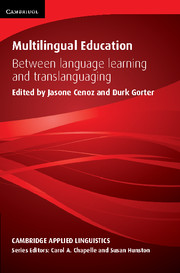Book contents
- Frontmatter
- Contents
- List of contributors
- Series editors’ preface
- Acknowledgements
- 1 Towards a holistic approach in the study of multilingual education
- 2 L1 as a pedagogical resource in building students’ L2 academic literacy: pedagogical innovation in the science classroom in a Hong Kong school
- 3 Linking content, linking students: a cross-linguistic pedagogical intervention
- 4 The role of the native language in the literacy development of Latino students in the United States
- 5 A nexus analysis of code choice during study abroad, and implications for language pedagogy
- 6 Multilingual practices in foreign language study
- 7 Language choices and ideologies in the bilingual classroom
- 8 Communicative repertoires in the community language classroom: resources for negotiating authenticity
- 9 Complementary classrooms for multilingual minority ethnic children as a translanguaging space
- 10 Constructing in-between spaces to ‘do’ bilingualism: a tale of two high schools in one city
- 11 Becoming multilingual and being multilingual: some thoughts
- Index
11 - Becoming multilingual and being multilingual: some thoughts
Published online by Cambridge University Press: 17 September 2021
- Frontmatter
- Contents
- List of contributors
- Series editors’ preface
- Acknowledgements
- 1 Towards a holistic approach in the study of multilingual education
- 2 L1 as a pedagogical resource in building students’ L2 academic literacy: pedagogical innovation in the science classroom in a Hong Kong school
- 3 Linking content, linking students: a cross-linguistic pedagogical intervention
- 4 The role of the native language in the literacy development of Latino students in the United States
- 5 A nexus analysis of code choice during study abroad, and implications for language pedagogy
- 6 Multilingual practices in foreign language study
- 7 Language choices and ideologies in the bilingual classroom
- 8 Communicative repertoires in the community language classroom: resources for negotiating authenticity
- 9 Complementary classrooms for multilingual minority ethnic children as a translanguaging space
- 10 Constructing in-between spaces to ‘do’ bilingualism: a tale of two high schools in one city
- 11 Becoming multilingual and being multilingual: some thoughts
- Index
Summary
From ‘language learning’ and ‘language use’ to ‘becoming multilingual’ and ‘being multilingual’
There is a long-standing issue in second language acquisition (SLA) and educational bilingualism studies of how to describe individuals in terms of their language-mediated identities. In Block ( 2003 ), I discuss a distinction made by researchers such as Susan Gass ( 1998 ) between language ‘learners’ and language ‘users’, the argument being, in effect, that researchers can and should distinguish between individuals when they are in language learning mode and when they are in language using mode. In making this distinction, Gass was making a programmatic statement about SLA as a field of inquiry in the larger field of what she called ‘second language studies’. She was also responding to Alan Firth and Johannes Wagner's ( 1997 ) prescient and oft-cited call for a broadening of SLA to take on frameworks and methodologies used in discourse analysis. She stated her position as follows:
the goal of my work (and the work of others within the input/interaction framework …) has never been to understand language use per se … but rather to understand what types of interaction might bring about what types of changes in linguistic knowledge … Nevertheless, it is true that in order to examine these changes, one must consider language use in context. But in some sense this is trivial; the emphasis in input and interaction studies is on the language used and not on the act of communication. This may appear to be a small difference, but to misunderstand the emphasis and the research questions … can result … in fundamental misinterpretations and naïve criticism. In fact, the result is the proverbial (and not very useful) comparison between apples and oranges.
(Gass, 1998 : 84)This perspective, eminently linguistic at the expense of a broader view of SLA which would include communication writ large, is represented in Figure 11.1 below.
In this case, SLA is understood as ‘linguistic-cognitive’ (Ortega, 2013 ), as exclusively about linguistic development and the cognitive processes leading to it. Two statements made by Gass in her 1998 article make this case clearly.
- Type
- Chapter
- Information
- Multilingual EducationBetween Language Learning and Translanguaging, pp. 225 - 238Publisher: Cambridge University PressPrint publication year: 2015
- 8
- Cited by



